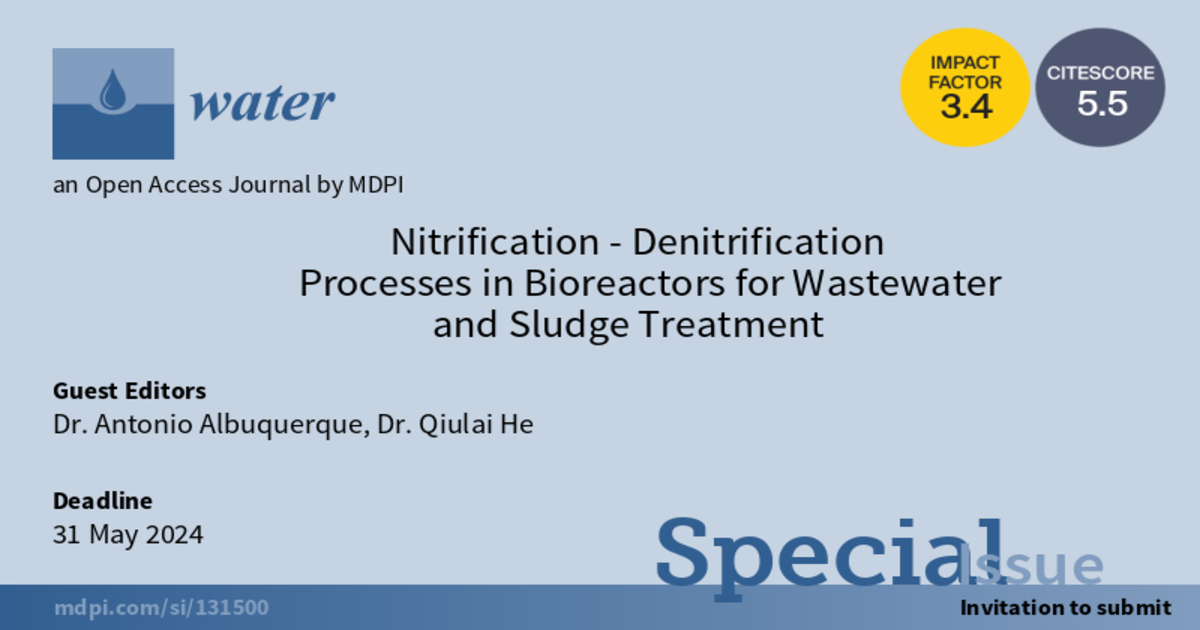- 3.0Impact Factor
- 6.0CiteScore
- 20 daysTime to First Decision
Nitrification-Denitrification Processes in Bioreactors for Wastewater and Sludge Treatment
This special issue belongs to the section “Wastewater Treatment and Reuse“.
Special Issue Information
Dear Colleagues,
Nitrogen and phosphorous removal remain important and pressing challenges for water utilities with a view to discharging treated effluents into waterways or reusing water. In the last decade, significant advances have been observed in biological nutrient removal (BNR) through nitrification-denitrification pathways, either in wastewater or sludge treatment, using suspended sludge, hybrid flow, or biofilm reactors, with important discoveries on anaerobic ammonium oxidation, partial nitritation (SHARON, OLAND, CANON, and aerobic/anoxic deammonification processes), archaeal nitrification, and co-denitrification, as well as on the influence of the C/N ratio and interrelation between nitrifying, denitrifying, and phosphorus accumulating micro-organisms. Nowadays, research is focused on topics, such as the role of the alga-bacteria consortium in the simultaneous removal of N and P, optimization of nitrification-denitrification and phosphorous removal processes associated with sludge volume reduction, nutrient recovery towards the circular economy, nitrogen removal with minimal carbon demand, diversion of carbon for increasing biomethane production and lower carbon footprint, and reduction of greenhouse emissions. Therefore, this Special Issue aims to bring the most recent and innovative research on BNR, taking into account new challenges on sustainable water reuse, reduction of greenhouse emissions, circular economy, and needs in upgrading or retrofitting existing facilities.
Main topics are:
- New developments and challenges in BNR;
- Granular sludge for BNR;
- Biological phosphorus removal in sludge acid fermentation;
- Greenhouse emissions reduction in BNR;
- Nutrient recovery;
- Algal technology for BNR;
- Modelling advances in BNR;
- Sludge treatment and reduction technologies in BNR.
The Special Issue on “Nitrification-Denitrification Processes in Bioreactors for Wastewater and Sludge Treatment” is now open for submissions to be published as part of journal Water.
Dr. Antonio Albuquerque
Dr. Qiulai He
Guest Editors
Manuscript Submission Information
Manuscripts should be submitted online at www.mdpi.com by registering and logging in to this website. Once you are registered, click here to go to the submission form. Manuscripts can be submitted until the deadline. All submissions that pass pre-check are peer-reviewed. Accepted papers will be published continuously in the journal (as soon as accepted) and will be listed together on the special issue website. Research articles, review articles as well as short communications are invited. For planned papers, a title and short abstract (about 250 words) can be sent to the Editorial Office for assessment.
Submitted manuscripts should not have been published previously, nor be under consideration for publication elsewhere (except conference proceedings papers). All manuscripts are thoroughly refereed through a single-blind peer-review process. A guide for authors and other relevant information for submission of manuscripts is available on the Instructions for Authors page. Water is an international peer-reviewed open access semimonthly journal published by MDPI.
Please visit the Instructions for Authors page before submitting a manuscript. The Article Processing Charge (APC) for publication in this open access journal is 2600 CHF (Swiss Francs). Submitted papers should be well formatted and use good English. Authors may use MDPI's English editing service prior to publication or during author revisions.
Keywords
- wastewater treatment
- biological nutrient removal
- nitrification-denitrification
- phosphorous removal
- nitrogen removal
- water reuse
- sludge treatment

Benefits of Publishing in a Special Issue
- Ease of navigation: Grouping papers by topic helps scholars navigate broad scope journals more efficiently.
- Greater discoverability: Special Issues support the reach and impact of scientific research. Articles in Special Issues are more discoverable and cited more frequently.
- Expansion of research network: Special Issues facilitate connections among authors, fostering scientific collaborations.
- External promotion: Articles in Special Issues are often promoted through the journal's social media, increasing their visibility.
- e-Book format: Special Issues with more than 10 articles can be published as dedicated e-books, ensuring wide and rapid dissemination.

